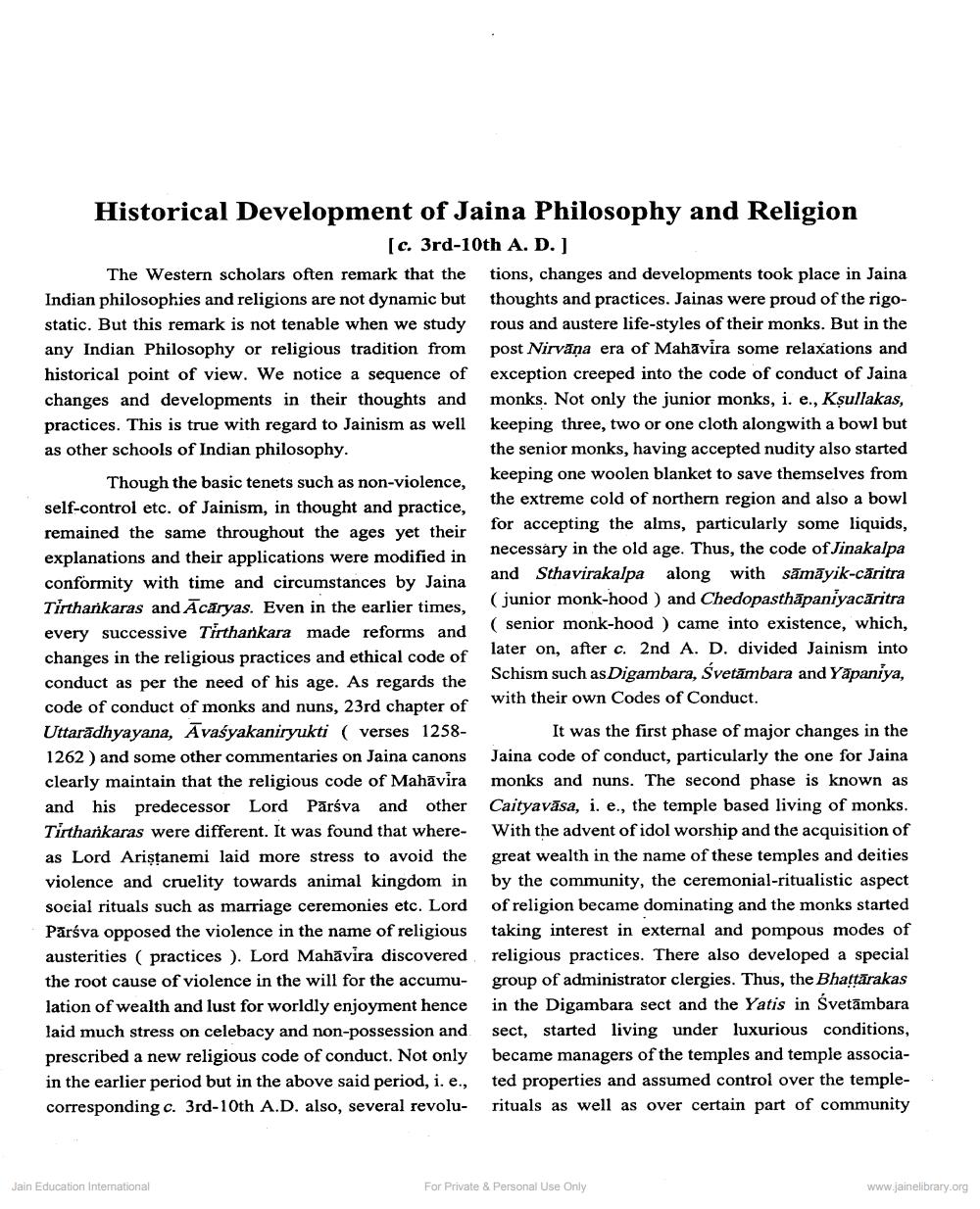Book Title: Historical Development Of Jaina Philosophy And Religion Author(s): Sagarmal Jain Publisher: Z_Jaina_Literature_and_Philosophy_a_Critical_Approach_001936_HR.pdf View full book textPage 1
________________ Historical Development of Jaina Philosophy and Religion (c. 3rd-10th A. D. ] The Western scholars often remark that the tions, changes and developments took place in Jaina Indian philosophies and religions are not dynamic but thoughts and practices. Jainas were proud of the rigostatic. But this remark is not tenable when we study rous and austere life-styles of their monks. But in the any Indian Philosophy or religious tradition from post Nirvana era of Mahavira some relaxations and historical point of view. We notice a sequence of exception creeped into the code of conduct of Jaina changes and developments in their thoughts and monks. Not only the junior monks, i. e., Kșullakas, practices. This is true with regard to Jainism as well keeping three, two or one cloth alongwith a bowl but as other schools of Indian philosophy. the senior monks, having accepted nudity also started Though the basic tenets such as non-violence, keeping one woolen blanket to save themselves from self-control etc. of Jainism, in thought and practice, the extreme cold of northern region and also a bowl remained the same throughout the ages yet their for accepting the alms, particularly some liquids, explanations and their applications were modified in necessary in the old age. Thus, the code of Jinakalpa conformity with time and circumstances by Jaina and Sthavirakalpa along with sāmāyik-căritra Tirtharikaras and Acaryas. Even in the earlier times, (junior monk-hood ) and Chedopasthāpaniyacaritra every successive Tirthankara made reforms and (senior monk-hood ) came into existence, which, changes in the religious practices and ethical code of later later on, after c. 2nd A. D. divided Jainism into conduct as per the need of his age. As regards the Schism such as Digambara, Svetāmbara and Yapaniya, code of conduct of monks and nuns, 23rd chapter of with th ter of with their own Codes of Conduct. Uttarādhyayana, Avaśyakaniryukti ( verses 1258 It was the first phase of major changes in the 1262 ) and some other commentaries on Jaina canons Jaina code of conduct, particularly the one for Jaina clearly maintain that the religious code of Mahāvira monks and nuns. The second phase is known as and his predecessor Lord Pārśva and other Caityavāsa, i. e., the temple based living of monks. Tirtharkaras were different. It was found that where- With the advent of idol worship and the acquisition of as Lord Aristanemi laid more stress to avoid the great wealth in the name of these temples and deities violence and cruelity towards animal kingdom in by the community, the ceremonial-ritualistic aspect social rituals such as marriage ceremonies etc. Lord of religion became dominating and the monks started Pārsva opposed the violence in the name of religious taking interest in external and pompous modes of austerities ( practices ). Lord Mahāvira discovered religious practices. There also developed a special the root cause of violence in the will for the accumu- group of administrator clergies. Thus, the Bhattārakas lation of wealth and lust for worldly enjoyment hence in the Digambara sect and the Yatis in Svetāmbara laid much stress on celebacy and non-possession and sect, started living under luxurious conditions, prescribed a new religious code of conduct. Not only became managers of the temples and temple associain the earlier period but in the above said period, i. e., ted properties and assumed control over the templecorresponding c. 3rd-10th A.D. also, several revolu- rituals as well as over certain part of community Jain Education International For Private & Personal Use Only www.jainelibrary.orgPage Navigation
1 2 3 4 5 6 7 8 9 10 11 12 ... 39
